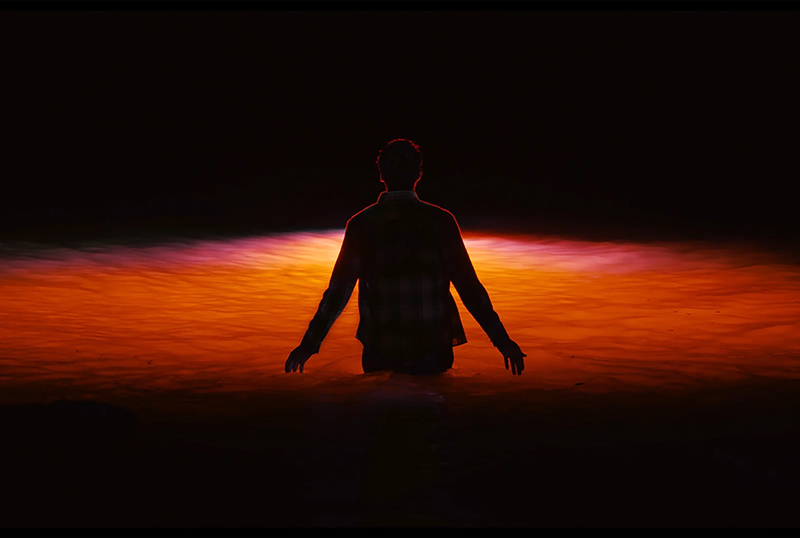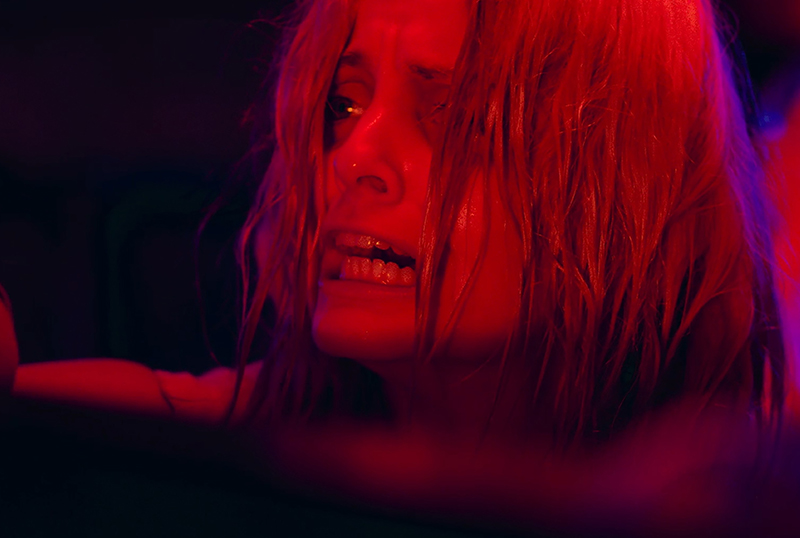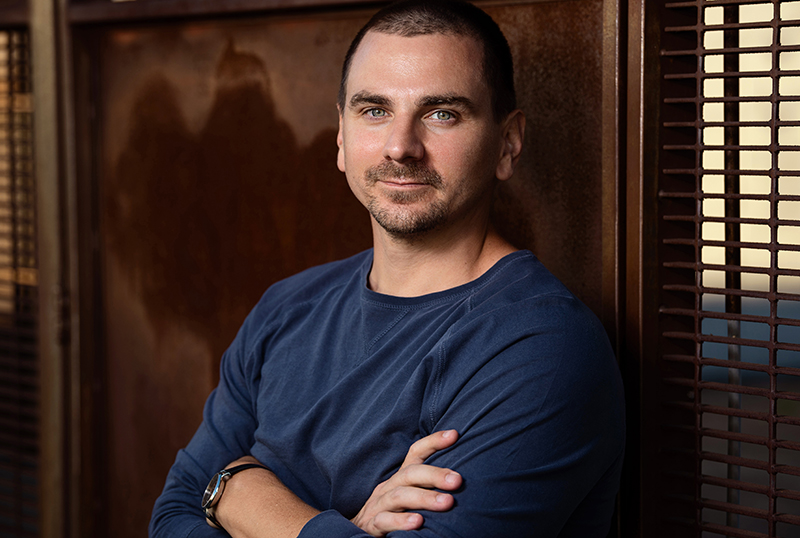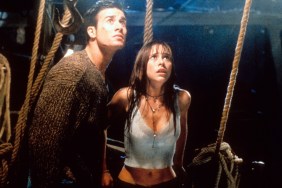Just in time for the film’s digital and VOD release, ComingSoon.net got the opportunity to dive into the mind of writer/director Braden R. Duemmler to discuss his feature debut, the sci-fi thriller What Lies Below, which is now available on Apple TV, Amazon and other digital platforms! Click here to rent or purchase the film!
RELATED: CS Interviews: Werner Herzog and Clive Oppenheimer Discuss Fireball
ComingSoon.net: How did the concept for the film come to your mind?
Braden R. Duemmler: The impetus of the film is really the light in the lake scene. When I first pictured the image in my head, however, it was a beam of light from the sky hitting a man in the chest. I have no doubts the image was borrowed from some poster or still-frame of a movie that’s so deeply buried in the recesses of my mind that I can no longer access it. Nevertheless, I was obsessed with that moment, that image, and wanted to build something around it. I started to ask myself; who sees the man and the light? What is their relationship to that person? And that’s when I was reminded of my own childhood; when my first ever crush blossomed at 5 years old towards my future Stepmother, Sandy. Looking back on the affections Sandy and I shared, we can still laugh at their innocence, but if the roles were reversed and I was a little girl and Sandy was a man, our adorable flirtations feel a lot more problematic. So, I began to synthesize that family dynamic of a girl and her future stepdad into my light idea, allowing the relationship to shape the story and the ethos I created around John Smith. Ultimately, the story is horror and thriller and drama, but it was always driven by its mystery. What does John want? What will he do? And what is that light in the lake?
CS: What was it about this film drove you to want to make it your feature directorial debut?
BRD: Before I wrote What Lies Below, I felt the industry was turning a corner; it seemed as though filmmakers were suddenly producing more and more female-driven stories. As a man who grew up very close to his Mother and Stepmother and has three sisters, I wanted to support that movement the only way I knew how, by writing. Of course, I was completely intimidated, at first, by the prospect of scripting a teenaged, female, protagonist. However, I took my time and spoke with my sisters and Moms and read enlightening literature on Female psychological development through the teenage years, as well as the sociological context of teenage America, and slowly felt more-and-more prepared to capture a female perspective with my writing and the lens. While I hope What Lies Below captivates everyone, I’ve often felt most encouraged when any of my female collaborators read the script or watch the film and say, “you wrote that? Really?”
CS: What were some of the biggest challenges, creatively and practically, in making this your debut?
BRD: Oh man, there were so many challenges it’s hard to choose. The lampreys, for instance, were incredibly difficult to get on set. They are actually a very invasive species that are considered a cancer to any ecosystem they infest. As a result, whenever they are caught, they are supposed to be immediately exterminated. That means they can’t be stored, can’t cross state lines, and therefore can’t be brought to set. We were only able to shoot the lamprey (that’s right, one lamprey) that you see because I had a friend who is a biologist and happens to be studying their effects on a lake in Vermont. So, that one, single, lamprey (the one they caught) was shot many times to look like a multitude.

I’d also be remiss if I didn’t mention the challenges of the light in the lake scene. We shot in Lake George, which was incredibly beautiful, but also had very steep and jagged beaches in its most isolated areas. As a result, it was really hard to find a slow, gradual, decline into the water that I felt was necessary to facilitate John’s hauntingly casual descent. When we finally found a perfect location, I was relieved, though we had to use three different houses, to look like one, in order to make it work. Finally, on the day of the actual shoot, the 4,000 watt light we were using in the lake not only wasn’t as powerful as we had hoped, but a screw that kept the casing together broke! So, our team struggled for hours trying to figure out a way to get the light to hold together long enough, and stay straight enough, so we could get our shot. We lost 3 hours on that day because of a single screw! Which shows you how important every little detail is when making a movie.
CS: Given the smaller cast list, what was it like searching for the perfect performers for their respective roles?
BRD: I was very fortunate that our Producers Abel Vang and Stephen Stanley found our Casting Director, Katrina Wandel George. From the outset, Katrina believed in the script because she felt a personal connection to it. So, she shot for the stars which ultimately lead to Mena coming on board. In a million years, I never expected to land such a talented actress to headline our cast! Personally, I very much relied on Mena’s wealth of experience and knowledge. She is such a powerhouse and consummate professional, and her faith in me pacified my own insecurities, instilling in me even more confidence in the material.
I still remember shooting the living room scene (where Michelle slaps Libby) and due to our schedule, we had to shoot Mena last, even though it was a very emotionally and physically draining scene for her and her character. When our Assistant Director asked if it was okay to shoot Mena’s coverage at the end, I knew without-a-doubt, it would be fine. And sure enough, as Mena had proven time-and-time again throughout the shoot, it didn’t matter if it was the first take or the last, she was going to bring all the energy, emotion and depth needed for every moment and beat. I’ll always be amazed by that fierceness, determination and talent. To this day, I’m convinced her reputation had a great impact on the talent we were able to attract through the audition process for the other roles.
Haskiri was the last cast member we found through that audition process. I immediately gravitated to her because she had a fire in her belly that was so critical to Marley’s character. I still recall a particular shot where I had to help Haskiri hold a very difficult position (we’ll have to leave it at that because I don’t want to give too much away), by grabbing her hips. Of course, I wanted to be respectful of her boundaries and didn’t want to grab her too tightly, but eventually Haskiri turned around and said, “Brad, it’s fine; just grab me!” Like Marley, Haskiri was blunt, outspoken, and viciously dedicated and I saw that shine through whenever she performed. Trey was another standout from the casting process. I remember his audition so clearly because he had this incredible penchant for expanding the depth of the material. He made lines that weren’t creepy, completely sinister and actions that were rudimentary became dynamic. Trey’s creativity continued on set and although we maintained our game-plan, we always afforded ourselves extra takes for any and all ideas.
RELATED: CS Video: Mortal Interview With Co-Writer/Director André Øvredal
In addition to that boldness, I found Trey possessed incredible control over his facilities as a performer. I knew that control would be intrinsic to our shoot because when first sharing the script, I found readers would react in extremely varying degrees to the same subtleties on the page. So, I had to decide what would be the best way to maintain a bit of control over a viewing experience that may arouse very divergent reactions. Since we could never be sure how an audience would react to an edit, I felt I needed an actor who could give me plenty of options and variations of the text, so I could alter and adjust the edit accordingly. So, in moments like the shoulder rub in the dining room, for instance, Trey and I were able to create a creep barometer and Trey would literally dial the creep up or down depending on the take. In many cases, with our limited time, we would just run a series where Trey would perform the action and I would simply say 1, 3, 6, or 10 to give us the different degrees of John Smith’s creepiness. Having those options in the edit was an unsung hero of the film and allowed us to control the viewer’s expectations throughout the story.
Ema was another incredible talent we were fortunate to find through the audition process. I still remember being so intrigued by her tape that I had to share it with a friend. The friend said, “she has a real Jack Nicholson quality to her” to which I replied… “ahhh… What?” That’s when he explained, “she’s either completely crazy or a genius.” It didn’t take long on set for me to realize the latter was true. Ema is incredibly cerebral and calm when she works. I’m usually pacing in the hall, staring at the ground, while she’s swaying in her makeup chair with a similarly fixated gaze. Between every setup she is in her head, thinking about the moment, the scene, the beat. We would talk and prepare, and she would internalize every note, and then once I said action it would explode in front of my eyes in the most mesmerizing ways. Her presence is so strong and captivating that she can make the subtlest shift in her look or her eyes or her smile and it will feel like something completely fresh and raw. It was incredible to watch her command and her ability to ground Libby very much anchored the film through what is a very turbulent and twisting plot. I’m so thankful for her and her talent. She is the star of our story.
CS: Without outright spoiling it, the ending is really quite the shocker, what was the thought process behind it?

BRD: I’m glad it shocked you a bit as that is the intention. I would encourage anyone who is startled by the ending to re-watch the film with it in mind. At its core, What Lies Below is a mystery and there are clues littered throughout the film that culminate in those final scenes and that last shot. I fear I’m teetering on a tight rope here between cryptic and lucid so I’ll just say this: the final scene was one of the earliest shots in my head. For me, it answers the who, what, where, and why of our mystery. Part of the why, for instance, is distinguished by a physical trait shared by all the subjects in the shot. That trait influenced our casting, our makeup, and much of our dialogue. But, it only becomes fully evident in that final shot.
CS: There’s a really detailed feeling to the science behind the film, how much research did you have to compile on the science behind it all before penning the script?
Ha! I’m so glad it felt detailed. As a writer, I believe authenticity and empathy emanate from specifics rather than generalities. So, whenever I write a script, I work as hard to find the right word or phrase for a specific moment, as I do to plot the entire story. I think that’s why writers hate writing so much; we torture ourselves over every single word! When researching the science for What Lies Below, I first placed the cart before the horse; meaning I spent a lot of time, perhaps a week, reading any science that could relate to the story (much of which never made it onto the page). Then, once the story started to take shape, I would research, in great detail, any moment that was important to a particular story beat. For instance, the experiment at the dining room table, which was a combination of a real experiment and artistic liberty (wink), took a while to find because I knew I needed something specific to John and his research. This also holds true of the lampreys which I found because I looked for a species that checked a bunch of boxes I had in my head based on the initial research for the story.
So, overall, the research was constant and ongoing from ideation to final draft. I hope it feels authentic to the audience. I feel I’ve accomplished my goal if you can’t tell what’s made up and what’s real.
RELATED: CS Interview: Beck & Woods on Haunt Collector’s Edition, Quibi & 65!
Liberty, a socially awkward 16-year-old, returns from two months at camp to a blindsided introduction of her Mother’s fiancé, John Smith, whose charm, intelligence and beauty paint the picture of a man too perfect to be human. The cast for the film includes Ema Horvath (The Gallows Act II, The Lord of the Rings), Trey Tucker (The Space Between Us, The Outpost) and Mena Suvari (American Woman, American Horror Story: Apocalypse).
What Lies Below is now available on digital platforms and VOD!










